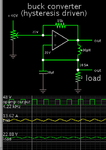Plecto
Full Member level 5
Hi. I need to design a switching regulator with 48V input, 0-40V, 0-10A output. I've chosen the LM5117 for this purpose. I want a pose a general question regarding switch mode regulators like these. If we disregard efficiency, component size and cost, and bandwidth, what would I do to make this regulator stable regardless of output voltage and output current? The output voltage is adjusted by a filtered PWM connected to the feedback path by the way.
